List of stumbling blocks in the Marienburg district of Cologne
The list of the stumbling blocks in the Cologne district Marienburg results by artist Gunter Demnig laid stumbling blocks in the Cologne district of Marienburg on.
The list of stumbling blocks is based on the data and research of the NS Documentation Center of the City of Cologne , partially supplemented by information and comments from Wikipedia articles and external sources. The aim of the art project is to document biographical details of the people who had their (last) voluntarily chosen residence in Cologne in order to preserve their memory.
- Note: In many cases, however, it is no longer possible to comprehend a complete description of their life and their path of suffering. In particular, the circumstances of her death can often no longer be researched. Official death notices from ghettos, detention centers, hospitals and concentration camps can often contain information that conceals the true circumstances of death, but are also documented taking this fact into account.
| image | Name and details of the inscription | address | Additional Information |
|---|---|---|---|

|
Here lived Johanna Auerbach , born Rothschild ( born 1873)
|
Parkstrasse 10 ( location ) |
The stumbling block is reminiscent of Johanna Selma Auerbach (née Rothschild) , born on April 2, 1873 in Cologne.
Johanna Selma Auerbach was the wife of Selmar Auerbach, the Cologne judiciary. The couple had two daughters. Her husband's law practice had been at Villa Parkstrasse 10 since 1917, which was built in 1914 by the architect Paul Pott . Since Selmar Auerbach had already received his appointment as a lawyer before 1914, his admission was retained after 1933. He fell ill in the spring of 1933 and died on May 5, 1934. After 1938, Johanna fled from the National Socialists to Holland ( Bussum , Groot Hertoginnelaan 44). The house at Parkstrasse 10 became the property of the Richard Fackeldey family ( Opekta ). On September 12, 1942, she was deported to the Westerbork transit camp. Two days later, on September 14, 1942, Johanna Auerbach was transported to Auschwitz with 901 other prisoners, where she arrived on September 16. On September 17, 1942, she was probably murdered with most of the prisoners on the transport in Auschwitz. |

|
Here lived Ulrike Auerbach ( born in 1907)
|
Parkstrasse 10 ( location ) |
The stumbling block is reminiscent of Ulrike Auerbach , born on August 13, 1907 in Cologne.
Ulrike Auerbach was the daughter of Johanna and Selmar Auerbach. She and her mother fled to Holland after 1938. Like her mother, she was deported to Auschwitz via Westerbork on September 12, 1942 and probably murdered on arrival on September 17, 1942. |

|
Here lived Maria Bing (married. Fittler) , ( born 1908)
|
Oberländer Ufer 208 ( location ) |
The Stolperstein, which was laid on November 23, 2017, commemorates Maria Fittler (née Bing) , born in 1908 in Cologne.
The stumbling block for Moritz Bing and his family was donated by the Rhineland-Cologne section of the German Alpine Club . |

|
This is where Dr. Moritz Bing ( born 1875)
|
Oberländer Ufer 208 ( location ) |
The Stolperstein, which was laid on November 23, 2017, commemorates Moritz Bing , born on March 23, 1875 in Cologne.
Moritz Bing was the son of an Israelite businessman and studied law. On July 5, 1897, he passed his legal traineeship in Cologne and received his doctorate on October 28, 1897 in Erlangen. He passed the assessor examination in September 1901 and became a court assessor. On April 21, 1902, Moritz Bing was admitted to the bar at the Cologne District and Regional Court . In 1915 Moritz Bing was called up for military service on the Western Front. Moritz Bing worked in various law firms and also worked as a patent attorney for the Cologne-based clothing manufacturer Bierbaum-Proenen since the late 1920s . Since the owner Franz Proenen (member of the NSDAP) wanted to hold onto his Jewish employees, he later had to face a party exclusion procedure. Moritz Bing worked for Bierbaum-Proenen until his escape in 1938. Due to the ban on Jewish and Aryan lawyers' partnerships , Moritz Bing resigned from his previous office community on September 29, 1933 and joined forces with Justice Councilor Albert Cahen II. As a former combatant at the front , Moritz Bing was initially able to continue practicing his profession. As part of the 5th implementing ordinance to the Reich Citizenship Act , his license to practice as a lawyer was withdrawn on November 30, 1938. During the November pogroms in 1938 he was arrested and deported to the Dachau concentration camp . Only after Moritz Bing had sold his houses at Oberländer Ufer 208 and Kermeterstrasse 3a was he released again. Moritz Bing fled to Switzerland in 1938. According to Reichsanzeiger No. 143 , his property was declared "forfeited to the Reich" on June 23, 1941. Moritz Bing died in Bern on November 13, 1947. Compensation claims by his heirs for the return of the Oberländer Ufer 208 property were later settled with a settlement payment of 35,000 DM for the house damaged in the war. The plot of land at Kermeterstrasse 3a was returned to the heirs and further settlements were made in relation to claims for reparation relating to confiscated assets, securities and jewelry. The stumbling block for Moritz Bing and his family was donated by the Rhineland-Cologne section of the German Alpine Club . Moritz Bing was a long-time member of the Cologne Alpine Club, including the lender for the construction of the Cologne house above Serfaus in Tyrol . Moritz Bing was the last member of the Jewish faith of the Cologne Alpine Club until August 1, 1937 and was an advocate against anti-Semitic tendencies in the Cologne Alpine Club until the end. |

|
This is where Dr. Susanne Bing (married Schmalenbach) , ( born 1905)
|
Oberländer Ufer 208 ( location ) |
The Stolperstein, which was laid on November 23, 2017, commemorates Susanne Schmalenbach (née Bing) , born on November 11, 1905 in Cologne.
Susanne Bing was the eldest daughter of the lawyer Moritz Bing and his wife Alice. The doctor of literature fled to Switzerland with her father in 1938 and married the Cologne-based art historian Fritz Schmalenbach in 1945 . She lived in Lübeck until her death in 1992 . The stumbling block for Moritz Bing and his family was donated by the Rhineland-Cologne section of the German Alpine Club . |

|
Anna Johanna Blumenfeld , nee lived here . Gelding ( born 1903)
|
Robert-Heuser-Str. 3 ( location ) |
The stumbling block is reminiscent of Anna Johanna Blumenfeld , born on July 20, 1903 in Cologne.
Anna Johanna Blumenfeld was the daughter of the businessman Albert Wallach and the wife of Paul Blumenfeld. The house of the Wallach-Blumenfeld family at Robert-Heuser-Str. 3, built in 1909/10 by Joseph Brandt, was sold by the couple in the summer of 1941 to the architect Wilhelm Hüttenmeister. The Blumenfeld family was not allowed to leave Germany in 1942 and the family was interned at Fort V Müngersdorf . The family and 444 Cologne Jews were deported to the Bardenberg transit camp near Aachen on June 10, 1942 with only hand luggage . 230 of them were brought back to Cologne on June 14th. From there, the Blumenfeld family was deported eastwards on June 15, 1942 at 3:50 a.m. with a transport together with 1,000 other people from the Koblenz, Aachen, Cologne and Düsseldorf area to an unknown destination, where their trail is lost. With effect from May 8, 1945, the family was pronounced dead. |

|
Here lived Paul Blumenfeld ( born in 1892)
|
Robert-Heuser-Str. 3 ( location ) |
The stumbling block reminds of Paul Blumenfeld , born June 29, 1892 in Essen .
Paul Blumenfeld was a Jewish lawyer and notary. After completing his studies, he first worked in Essen and moved to Cologne in 1935. His office was at Wörthstrasse 17 and he lived at Robert-Heuser-Strasse 3. Paul Blumenfeld was married to Anna Johanna Blumenfeld (née Wallach), a daughter of the Cologne merchant Albert Wallach. The couple had a daughter together (Ursula Blumenfeld, born 1931). In 1942 the family was not allowed to leave Germany and the family was interned at Fort V Müngersdorf . On June 15, 1942, the family was deported to the east with an unknown destination. With effect from May 8, 1945, the family was pronounced dead. Paul Blumenfeld's sister, Anna Rosa Blumenfeld, asserted claims for reimbursement after the war because of the family's assets, which had lapsed according to the 11th implementing ordinance of the Reich Citizenship Law . |

|
Here lived Ursula Blumenfeld ( born in 1931)
|
Robert-Heuser-Str. 3 ( location ) |
The stumbling block is reminiscent of Ursula Blumenfeld , born on August 12, 1931 in Essen.
Ursula Blumenfeld was the daughter of Paul and Anna Johanna Blumenfeld. The Blumenfeld family moved to Cologne in 1935 in the house of Anna Johanna Blumenfeld's parents. Ursel attended the Catholic kindergarten of the Sisters of the Holy Cross in Schillerstrasse. There is also a photograph of her from this time. The family was not allowed to leave Germany in 1942 and the family was interned at Fort V Müngersdorf . On June 15, 1942, she and her parents were deported to the east to an unknown destination. With effect from May 8, 1945, the family was pronounced dead. |
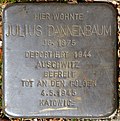
|
Here lived Julius Dannebaum ( born in 1875)
|
Tiberiusstrasse 14 ( location ) |
The Stolperstein, which was laid on March 11, 2015, commemorates Julius Dannenbaum , born in 1875.
Julius Dannenbaum died of the consequences of his imprisonment after his liberation. |
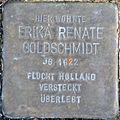
|
Here lived Erika Renate Goldschmidt ( born in 1922)
|
Ahrweilerstr. 8 ( location ) |
The stumbling block is reminiscent of Erika Renate Goldschmidt , born on February 12, 1922 in Cologne.
Erika Goldschmidt was the only daughter of Hilde and Richard Goldschmidt. She and her parents fled to Amsterdam in 1937. She survived the Holocaust and married Julius Rosenstein after the war. She died on December 10, 1969 in Amsterdam. |

|
Hilde Goldschmidt , nee lived here . Cohen ( born 1899)
|
Ahrweilerstr. 8 ( location ) |
The stumbling stone is reminiscent of Hilde Goldschmidt (née Cohen) , born on December 20, 1899 in Bocholt .
Hilde Goldschmidt was the daughter of the textile manufacturer Emil Cohen. On February 17, 1921, she married the Cologne jeweler E. Richard Goldschmidt. In 1937 the family fled to Amsterdam. On April 4, 1943, she was deported to the Herzogenbusch concentration camp. She survived the Holocaust and died on January 10, 1985 in Amsterdam. |

|
Here lived Ralph Richard Goldschmidt ( born in 1894)
|
Ahrweilerstr. 8 ( location ) |
The stumbling block is reminiscent of Ralph Richard Goldschmidt , born on March 4, 1894.
Ernst Richard Goldschmidt was the only son of the court jeweler Bernhard Goldschmidt. He had two older sisters (Alice, born December 13, 1890 and Else December 11, 1892). The Goldschmidt company, located at Domkloster 1, was founded by father Bernhard and uncle Joseph in Cologne. In 1928 the new office building, the "Goldschmidthaus" was built. Richard Goldstein fled with his family to Amsterdam in 1937, to Courbetstraat 27 / II. At the end of August 1939, his sister Else followed into exile. After the escape of the Goldschmidt family, the house and jewelry shop was taken over by Ewald Bräckerbohm (hence the Domkloster 1 office building is also known as the Bräckerbohm house). In April 1943 he was arrested and deported to the Westerbork transit camp. On May 4, 1943, he was transported to Sobibor on a transport of German and Dutch Jews, where he arrived on May 7, 1943. Here every trace of Richard Goldschmidt is lost, presumably he was murdered immediately after arriving at the Sobibor extermination camp . |
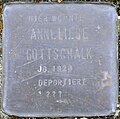
|
Here lived Anneliese Gottschalk ( born in 1920)
|
Eugen-Langen-Str. 29 ( location ) |
The stumbling block is reminiscent of Anneliese Gottschalk , born on October 20, 1920 in Cologne.
Anneliese / Annelie Gottschalk took on the family name Haubrich after their mother Alice married the second time in 1929 with the art patron and lawyer Josef Haubrich . Anneliese Gottschalk attended the Empress Augusta School . Because of the intensifying reprisals and the threat of arrest, Anneliese Haubrich fled to Denmark via Vienna in 1943. After the war she returned to Cologne, studied medicine and did her doctorate in 1952 at the University of Cologne on a gynecological topic. After her stepfather's death in 1963, she bequeathed part of the Haubrich art collection to the city of Cologne as one of the heirs, or gave the city a right of first refusal. |
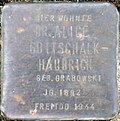
|
This is where Dr. Alice Gottschalk-Haubrich , b. Grabowski ( born 1892)
|
Eugen-Langen-Str. 29 ( location ) |
The stumbling block is reminiscent of Alice Haubrich-Gottschalk , born on January 11, 1892 in Konitz .
Alice Haubrich-Gottschalk was the daughter of Rabbi Viktor Grabowski. After completing school in Wuppertal and Remscheid, she studied medicine in Bonn, Munich and Berlin and did her doctorate in Bonn on a surgical topic. After completing her doctorate, she specialized in the field of paediatrics and gynecology. She ran a joint practice with her first husband, the dentist Fritz Gottschalk. In 1920 daughter Anneliese was born. In the mid-1920s, the marriage failed. In July 1929 she married the lawyer and art patron Josef Haubrich . After the National Socialists came to power, the Jewish doctor was harassed and had to give up her practice in 1938. Her non-Jewish husband was also forced to give up the law firm in the city. The daughter fled abroad in 1943. Alice Haubrich stayed at her husband's side in Cologne. When Alice Haubrich-Gottschalk was summoned for deportation by the Gestapo in February 1944, she saw no other way out than to commit suicide on February 10, 1944. |
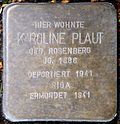
|
Here lived Karoline Plaut , born Rosenberg ( born 1886)
|
Marienburger Str. 52 ( location ) |
The Stolperstein, which was laid on April 12, 2016, commemorates Karoline Plaut , born in 1886. |
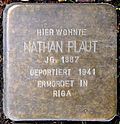
|
Here lived Nathan Plaut ( born in 1887)
|
Marienburger Str. 52 ( location ) |
The Stolperstein, which was laid on April 12, 2016, commemorates Nathan Plaut , born in 1887. |

|
Here lived Hans Rollmann ( born in 1877)
|
Pferdmengesstr. 25 ( location ) |
The stumbling block is reminiscent of Hans Rollmann , born on August 10, 1877 in Cologne.
Hans Rollmann was a shoe manufacturer in Cologne. In 1911 Rollmann took over his parents' shoe factory Rollmann & Mayer and in 1921 founded the shoe factory Romika with two partners . Hans Rollmann had been married to Marie Hertz since 1909, and the couple had three sons together. As members of the Jewish religion, they were discriminated against, persecuted and expropriated by the National Socialists. Fled to Belgium in 1935, after the Wehrmacht invaded Belgium, fled to France. After the Wehrmacht marched into France on May 25, 1940, the couple committed suicide. The sons were able to emigrate to the USA. Another stumbling block was relocated for Hans Rollmann at his former school, the Kreuzgasse grammar school . |

|
Here lived Marie Roll man , born Hertz ( born 1889)
|
Pferdmengesstr. 25 ( location ) |
The stumbling block is reminiscent of Marie Rollmann , born on October 8, 1889 in Cologne.
Marie Rollmann was the wife of the shoe manufacturer Hans Rollmann. The couple had three sons. As members of the Jewish religion, they were discriminated against, persecuted and expropriated by the National Socialists. Fled to Belgium in 1935, after the Wehrmacht invaded Belgium, fled to France. After the Wehrmacht marched into France on May 25, 1940, the couple committed suicide. The sons were able to emigrate to the USA. |

|
Here lived Alice Rosenberg , born Businessman ( born 1902)
|
Marienburger Str. 52 ( location ) |
The Stolperstein, which was laid on April 12, 2016, commemorates Alice Rosenberg , born in 1902. |
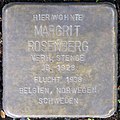
|
Here lived Margit Rosenberg , married. Stenge ( born 1928)
|
Marienburger Str. 52 ( location ) |
The Stolperstein laid on April 12, 2016 commemorates Margit Rosenberg , born in 1928. |

|
Here lived Markus Rosenberg ( born in 1890)
|
Marienburger Str. 52 ( location ) |
The Stolperstein, which was laid on April 12, 2016, commemorates Markus Rosenberg , born in 1890. |
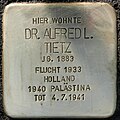
|
This is where Dr. Alfred L. Tietz ( born 1883)
|
Parkstrasse 61 ( location ) |
The Stolperstein, which was laid on March 18, 2019, reminds of Dr. Alfred L. Tietz , born on June 8, 1883 in Stralsund .
Alfred Leonhard Tietz was the eldest son of the Jewish department store founder Leonhard Tietz . After completing his training at the commercial school in Cologne, Alfred Leonhard worked as an apprentice in his father's department store. After his father's death in 1914, Alfred Tietz took over the Leonard Tietz AG department store group. During the First World War , Alfred Tietz was called up for military service. In the 1920s, despite economic difficulties, he built the company into one of the leading department store groups in Germany. Alfred Tietz was a member of the German Industry and Trade Conference and was on the board of numerous charitable organizations in Cologne. After the National Socialists seized power , Alfred Tietz was pushed out of the board of the department store group, his company aryanized and renamed Kaufhof AG . He and his wife Margarete fled from Cologne to the Saar region . In 1934 he emigrated to Amsterdam . Immediately before the Wehrmacht marched into Amsterdam, he fled to Palestine on the last ship to leave, where he died in Jerusalem on August 4, 1941 . The laying of the Stolperstein was initiated by the Rhineland Cologne section of the German Alpine Club . |

|
Here lived Herta Gabriele Tietz , married. Frenkel ( born 1915)
|
Parkstrasse 61 ( location ) |
The Stolperstein, which was laid on March 18, 2019, reminds of Herta Gabriele Tietz Verh. Frenkel was born on March 14, 1915 in Cologne.
Herta Gabriele Tietz was born in Cologne as the second child of Alfred and Margarete Tietz in Cologne. Together with her parents and grandmother Flora Tietz, she fled to Amsterdam at the end of March 1933 . In 1940, shortly before the Wehrmacht marched into Amsterdam, the Tietz family managed to flee to Palestine . Herta Tietz studied medicine here. In spring 1944 she received her license to practice medicine (DR.3476). On May 6, 1946, she married the physician Maurits Frenkel. The couple had three children. After the Second World War, Hertha Frenkel-Tietz worked as a general practitioner in the Netherlands. She died on July 29, 2011 in Bussum . |

|
Here lived Margaret Tietz , born Dzialoszynski ( born 1887)
|
Parkstrasse 61 ( location ) |
The Stolperstein, which was laid on March 18, 2019, reminds of Margarete Tietz, née Dzialoszynski , born on August 31, 1887 in Berlin .
Margarete Caecilie Tietz began a pedagogical training after graduating from secondary school for girls. She then studied social work in Berlin. After that she taught children in need. In 1909 she married the Cologne merchant Alfred Leonhard Tietz . Margarete Tietz was also involved in the social field in Cologne; u. a. in the Association for Jewish Nurses, in the Association for Maternal and Children's Rights; during the First World War in the Patriotic Women's Association . In the 1920s she founded the summer camp for working women and co-founded the Cologne family service and in 1929 the Cologne GEDOK . After the National Socialists came to power , Margerete Tietz fled with her husband from Cologne to the Saar area on July 9, 1933 , and then to Amsterdam in 1934 . Before she emigrated to Palestine in 1940 , she was involved in refugee aid in Amsterdam. Shortly after arriving in Jerusalem , her husband died. In 1948 she moved to the United States and took care of refugees and survivors of the Holocaust in particular . In the 1960s she founded the Margaret Tietz Nursing & Rehabilitation Center , which is still a residential home and nursing home to this day. Margarete Tietz died on February 26, 1972 while traveling in London . |

|
Here lived Ulrich Albert L. Tietz ( born in 1920)
|
Parkstrasse 61 ( location ) |
The Stolperstein laid on March 18, 2019 commemorates Ulrich Albert L. Tietz , born on February 13, 1920 in Cologne.
Ulrich Albert Leonard Tietz was born in Cologne as the youngest child of Alfred and Margarete Tietz in Cologne. After the National Socialists came to power, Ulrich Tietz had to interrupt his school education in Cologne. In 1933 he went to Switzerland to continue his training. In 1934 he followed his family to Amsterdam . Until 1938 he studied at a textile school. From November 1938 to February 1939 he volunteered to support his mother in her work on the Jewish Refugee Committee . Before fleeing to Palestine in March 1940, he completed an apprenticeship in a department store. In Jerusalem he first received training in a textile printing company, in which he later became a partner. In 1943 he volunteered for the Royal Air Force . After the Second World War he worked as an employee in an import-export business. He and his mother emigrated to the United States in January 1948 . On May 28, 1949, he married Esther Faerber in France. He was initially employed by the Associated Metals and Minerals Corp. He later worked at this company as the head of the finance department. In the following years he held numerous offices, including a. as President of the New Jersey Fellowship Fund for the Aged; Vice President of the American Federation of Jews of Central Europe, board member of the Jewish Philanthropy Fund and the Leo Baeck Institute , the New York Found for Nursing Homes and the Margaret Tietz Center for Nursing Care in New York. Ulrich Tietz died on November 6th, 2011 in a retirement home in New Rochelle . |
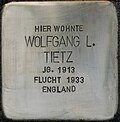
|
Here lived Wolfgang L. Tietz ( born in 1913)
|
Parkstrasse 61 ( location ) |
The Stolperstein laid on March 18, 2019 commemorates Wolfgang L. Tietz , born in 1913.
Wolfgang Leonard Tietz was born in Cologne as the eldest child of Alfred and Margarete Tietz in Cologne. After finishing school, Wolfgang Tietz studied in Cologne. Immediately after the National Socialists came to power , he fled to Great Britain. After emigrating , he changed his name. As Leonard Deeds, he began to work in the Marks & Spencer department store group . Later he headed the export department of the department store group as a senior manager . Together with his wife, Marlys Deeds (née Levy), he was a founding member and early supporter of Amnesty International . |
source
Individual evidence
- ↑ Klaus Luig : ... because he is not of Aryan descent. Jewish lawyers in Cologne during the Nazi era . 1st edition. Publishing house Dr. Schmidt, Cologne 2004, ISBN 3-504-01012-6 , pp. 108 f .
- ^ Digital Monument to the Jewish Community in the Netherlands: Johanna Auerbach-Rothschild
- ^ Bundesarchiv.de: memorial book entry for Auerbach, Johanna Selma
- ^ Bundesarchiv.de: memorial book entry for Auerbach, Ulrike
- ↑ Helmut Vogt: Bierbaum-Proenen 1929–1952 . A family business during the Great Depression, National Socialism and Reconstruction. 1st edition. JP Bachem Verlag, Cologne 2012, ISBN 978-3-7616-2606-1 , p. 82-83 .
- ↑ Klaus Luig : ... because he is not of Aryan descent. Jewish lawyers in Cologne during the Nazi era . 1st edition. Publishing house Dr. Schmidt, Cologne 2004, ISBN 3-504-01012-6 , pp. 113-115 .
- ↑ dav-koeln.de: Topic anti-Semitism , accessed on December 28, 2017
- ↑ dav-koeln.de: “Whoever wants to become a member must be of Aryan descent.” Anti-Semitism in the Rhineland-Cologne section of the Alpine Association (pdf), accessed on December 28, 2017
- ↑ historischesarchivkoeln.de: Price authority for land
- ↑ a b c deportation list of the train on June 15, 1942 Koblenz - Aachen - Cologne - Düsseldorf to unknown
- ↑ a b c Klaus Luig : ... because he is not of Aryan descent. Jewish lawyers in Cologne during the Nazi era . 1st edition. Publishing house Dr. Schmidt, Cologne 2004, ISBN 3-504-01012-6 , pp. 117-118 .
- ↑ a b Liesel and Ursel a childhood friendship. Ursula Blumenfeld (1831-). In: Kirsten-Serup Bilfeldt: Stolpersteine - Forgotten names, blown traces. Guide to the fate of Cologne during the Nazi era . Kiepenheuer & Witsch, Cologne 2004, 2nd edition, ISBN 3-462-03535-5 , pp. 13-21.
- ↑ Karl Kollmann , York-Egbert König : Names and fates of the Jewish victims of National Socialism from Eschwege - A memorial book. Nicolas Gasoline Foundation, Eschwege 2012, ISBN 978-1-4709-7182-3 , p. 177.
- ^ Central database of the names of Holocaust victims Yad Vashem
- ^ Digital Monument to the Jewish Community in the Netherlands: Ernst Richard Goldschmidt
- ^ Haubrich, Josef (pseudonym Dr. Ludwig Josef). on: deutsche-biographie.de
- ↑ A. Kladetzky-Haubrich: Observations on the venous outflow from the placenta on the basis of findings on an in situ fixed placenta from the 5th month . Dissertation . University of Cologne, 1952.
- ↑ historischesarchivkoeln.de: Modern documents (Best. 7550) U 99
- ^ Haubrich, Josef (pseudonym Dr. Ludwig Josef). on: deutsche-biographie.de
- ^ German Alpine Association - fourth stumbling block laying for former Jewish members. In: dav-koeln.de. German Alpine Club, Rhineland-Cologne section, accessed on March 24, 2019 .
- ^ Barbara Becker-Jákli: The Jewish Cologne past and present . Emons, Cologne 2012, ISBN 978-3-89705-873-6 , p. 147 .
- ↑ Joods Biographical Woordenboek. Retrieved March 24, 2019 .
- ^ Sybille Claus, Sybille, Beatrix Schmidt: International biographical dictionary of central European émigrés 1933-1945. Volume I, Politics, Economy, Public Life . Ed .: Werner von Röder; Herbert A. Strauss. De Gruyter Saur, Munich 1999, ISBN 3-11-096854-1 , p. 763 .
- ^ Barbara Becker-Jákli: The Jewish cemetery in Cologne-Bocklemünd: history, architecture and biographies . Cologne, ISBN 978-3-95451-889-0 , pp. 82 f .
- ↑ Irene Franken: Women in Cologne: the historical city guide . Bachem, Cologne 2008, ISBN 978-3-7616-2029-8 , pp. 276 .
- ↑ Werner Röder, Dieter M. Schneider, Herbert A. Strauss,: Biographical manual of the German-speaking emigration after 1933-1945: Volume 1: Politics, economy, public life . De Gruyter, Berlin 1980, ISBN 978-3-11-186584-3 , p. 763 .
- ↑ Paid Notice: Deaths Tietz, Ulrich Albert. Retrieved March 25, 2019 .
- ^ Anthony Grenville: Refugees from the Third Reich in Britain . Rodopi, Amsterdam 2002, ISBN 90-420-1104-1 , pp. 123; 130 .
- ↑ Werner Röder; Herbert A. Strauss (Ed.): International biographical dictionary of central European émigrés 1933-1945. Volume I, Politics, Economy, Public Life . De Gruyter Saur, Munich, ISBN 3-11-096854-1 , p. 763 .
- ↑ Barbara C. Crosby: Leadership for global citizenship: building transnational community . Sage Publications, Thousand Oaks 1999, ISBN 0-7619-1746-2 , pp. 37 .

